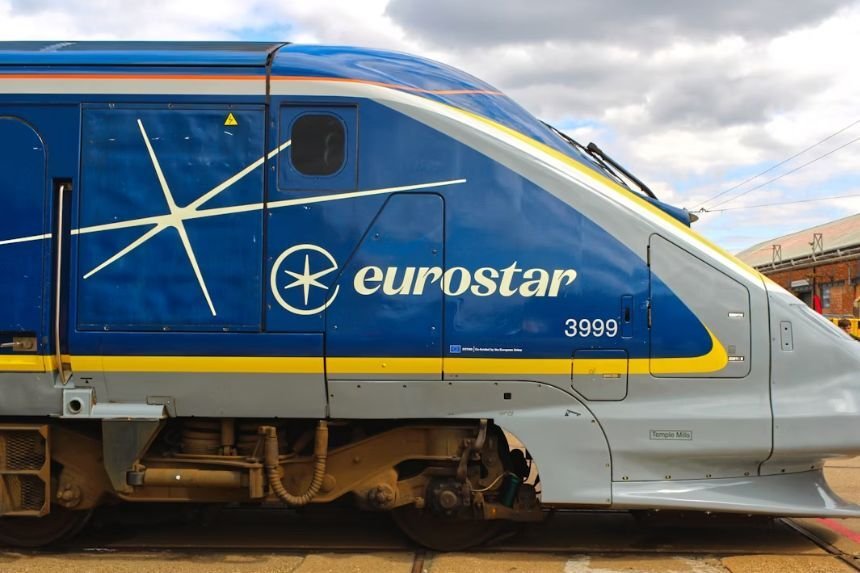Eurostar has officially revealed its next-generation double-decker trains, marking a major step forward in European high-speed rail travel. These innovative trains promise faster, greener, and more comfortable journeys across the continent.
- What Makes the Eurostar Double-Decker Trains Unique?
- Inside the Design and Comfort Features
- Eurostar’s Expansion and Route Plans
- Investment and Manufacturing Details
- Impact on Passengers and Competition
- Challenges and Timelines Ahead
- Public and Industry Reactions
- The Future of Sustainable Rail Travel in Europe
- Conclusion — A Bold Leap for European Mobility
- FAQs
With sleek designs, modern interiors, and sustainable technology, Eurostar aims to enhance passenger experience while reducing carbon emissions.
This launch is part of the company’s €2 billion investment to redefine international travel through the Channel Tunnel high-speed trains’ UK network.
What Makes the Eurostar Double-Decker Trains Unique?
A New Era for High-Speed European Travel
The launch of the Eurostar double-decker trains marks a defining moment in the history of European rail. Designed to enhance speed, comfort, and capacity, this new generation of trains aims to redefine the standards of international travel.
The introduction follows years of planning and signals Eurostar’s commitment to connecting Europe through efficient and sustainable rail infrastructure.
Eurostar has placed a major new train order with French manufacturer Alstom, continuing their long-standing partnership.
These next-generation trains are part of the Eurostar expansion plan 2031, which aims to increase capacity, improve service frequency, and strengthen cross-border travel between the UK and mainland Europe.
How the Design Improves Passenger Experience
Passengers can expect more than just a smooth ride. The Eurostar double-decker trains offer a seamless blend of comfort and innovation. The upper deck provides panoramic views of Europe’s landscapes, while upgraded interiors ensure a quiet, modern travel atmosphere.
Wider aisles, advanced lighting, and improved Wi-Fi connectivity will make long journeys more enjoyable and productive.
Inside the Design and Comfort Features
Spacious Seating and Modern Interiors
The new fleet—known as the Eurostar Celestia fleet—will deliver superior comfort and increased seating capacity. Each train will hold up to 900 passengers, offering 20% more capacity than existing models.
This move supports high-capacity international rail travel, responding to growing passenger demand between London, Paris, Amsterdam, and Brussels.
Luxury meets practicality with ergonomic seating, enhanced luggage storage, and upgraded accessibility for passengers with reduced mobility.
Sustainable Technology and Energy Efficiency
Sustainability is central to Eurostar’s modernization. The Alstom Avelia Horizon Eurostar design consumes 20% less energy while maintaining speeds up to 320 km/h.
Lightweight materials reduce environmental impact, aligning with Europe’s green transport initiatives and the broader sustainable European mobility rail goals.
Eurostar’s focus on eco-friendly technology makes these double-decker trains an important step toward decarbonizing the transport sector.
Accessibility Improvements for All Travelers
Accessibility has been prioritized throughout the design. From step-free boarding to accessible restrooms and clear signage, every detail ensures inclusivity.
These updates reinforce Eurostar’s mission to make international rail travel open to all passengers.
Eurostar’s Expansion and Route Plans
Destinations the New Fleet Will Serve
The Eurostar double-decker trains will primarily serve the London–Paris–Brussels corridor before expanding to new routes. Plans include Eurostar London, Frankfurt Geneva route options, offering passengers greater flexibility and convenience.
These expansions will help Eurostar strengthen its position as the leading provider of Channel Tunnel high-speed trains UK.
Future Connections Across Europe
Beyond Western Europe, Eurostar’s future expansion includes routes linking to Germany, Switzerland, and beyond. The vision is to create a connected, sustainable rail network capable of competing with short-haul flights.
The Eurostar expansion plan 2031 will make rail travel faster and more accessible for millions of European travelers.
How the Channel Tunnel Will Adapt to New Trains
The Channel Tunnel will undergo technical adjustments to accommodate the taller double-deck high-speed train UK fleet. Engineers are currently upgrading infrastructure and signals to ensure seamless operation and safety compliance.
Investment and Manufacturing Details
The €2 Billion Modernization Plan
Eurostar’s €2 billion investment represents one of the largest modernization efforts in the company’s history. The funding will cover 50 new trains, extensive testing, and a major Temple Mills depot upgrade in London. This project will create jobs and boost the UK’s manufacturing and maintenance sectors.
Collaboration with Train Makers and Engineers
The collaboration between Eurostar and Alstom highlights decades of expertise in rail innovation. Alstom’s Avelia Horizon model, part of the Eurostar new train order, blends aerodynamic design with advanced safety systems.
Engineers have also focused on reducing noise pollution and maintenance costs through streamlined components.
Economic and Environmental Benefits
This modernization plan will contribute to Europe’s shift toward green transport, supporting climate goals while stimulating economic growth. By choosing rail over air, passengers help reduce carbon emissions—making sustainable European mobility rail a tangible reality.
Impact on Passengers and Competition
What Travelers Can Expect On Board
From free Wi-Fi to onboard entertainment, travelers will enjoy a new level of comfort. Catering services will feature locally sourced European meals, while real-time travel updates will keep passengers informed.
This commitment to passenger satisfaction ensures that the Eurostar double-decker trains offer both luxury and efficiency.
How Eurostar Compares to Airlines and Other Rail Networks
Compared to short-haul flights, Eurostar’s high-speed services offer lower emissions, shorter boarding times, and city-center arrivals.
Competing operators may struggle to match this combination of speed, sustainability, and convenience, giving Eurostar a distinct edge in the UK train fleet modernization race.
Challenges and Timelines Ahead
Production, Testing, and Certification Phases
Manufacturing of the new trains began in 2025, with deliveries scheduled to start in 2028. Each unit will undergo extensive testing in France and the UK to ensure compliance with European safety standards.
The Channel Tunnel high-speed trains UK will only enter service once full certification is achieved.
Potential Delays and Operational Hurdles
Despite optimism, challenges remain. Complex border regulations, Brexit-related logistics, and infrastructure adjustments could delay deployment. Eurostar’s leadership, however, remains confident that early planning will minimize disruptions.
Public and Industry Reactions
Enthusiasm from Rail Enthusiasts and Commuters
The announcement has generated excitement among commuters and rail enthusiasts alike. Many see it as a positive sign of renewed investment in Europe’s rail future.
For frequent travelers, the new double-deckers represent faster, greener, and more comfortable cross-border journeys.
Expert Opinions on the Future of High-Speed Rail
Industry analysts view the Eurostar double-decker trains as a strategic move that will redefine long-distance rail competition in Europe. Experts emphasize that innovations like these will be key to shifting passengers away from flights and toward rail-based alternatives.
The Future of Sustainable Rail Travel in Europe
Eurostar’s Role in Europe’s Green Transport Goals
Eurostar’s commitment to sustainability extends beyond comfort and convenience. The company’s decision to invest in double-deckers strengthens its role in achieving Europe’s carbon-neutral transport targets.
By prioritizing energy-efficient design, Eurostar sets a new benchmark for sustainable European mobility rail systems.
How Double-Deckers Shape the Next Decade of Travel
The Eurostar Celestia fleet will influence the next generation of train design across Europe. Other operators are expected to follow suit, adopting high-capacity, low-emission models that blend performance with environmental responsibility.
Conclusion — A Bold Leap for European Mobility
The unveiling of the Eurostar double-decker trains represents more than a technological upgrade—it’s a commitment to innovation, comfort, and sustainability.
With a €2 billion investment, Eurostar is shaping the future of European travel by combining speed with eco-conscious design.
As the network expands and new routes emerge, travelers will enjoy faster, greener journeys that connect Europe like never before.
This bold step forward cements Eurostar’s position as a leader in modern rail mobility and sets the stage for the next era of international transportation.
FAQs
- When will Eurostar’s double-decker trains start running?
The first trains are expected to enter service by 2028, following testing and safety certification. - Who is building the new Eurostar trains?
The trains are being built by Alstom, using the Avelia Horizon design platform. - How much is Eurostar investing in the project?
Eurostar has committed €2 billion to develop and deploy its new double-decker fleet. - What routes will the new trains serve?
Initially, they will serve routes between London, Paris, and Brussels, with future expansion into Germany and Switzerland.
5. How are these trains more sustainable?
They use lightweight materials, consume less energy, and produce fewer emissions—supporting Europe’s green transport initiatives.








